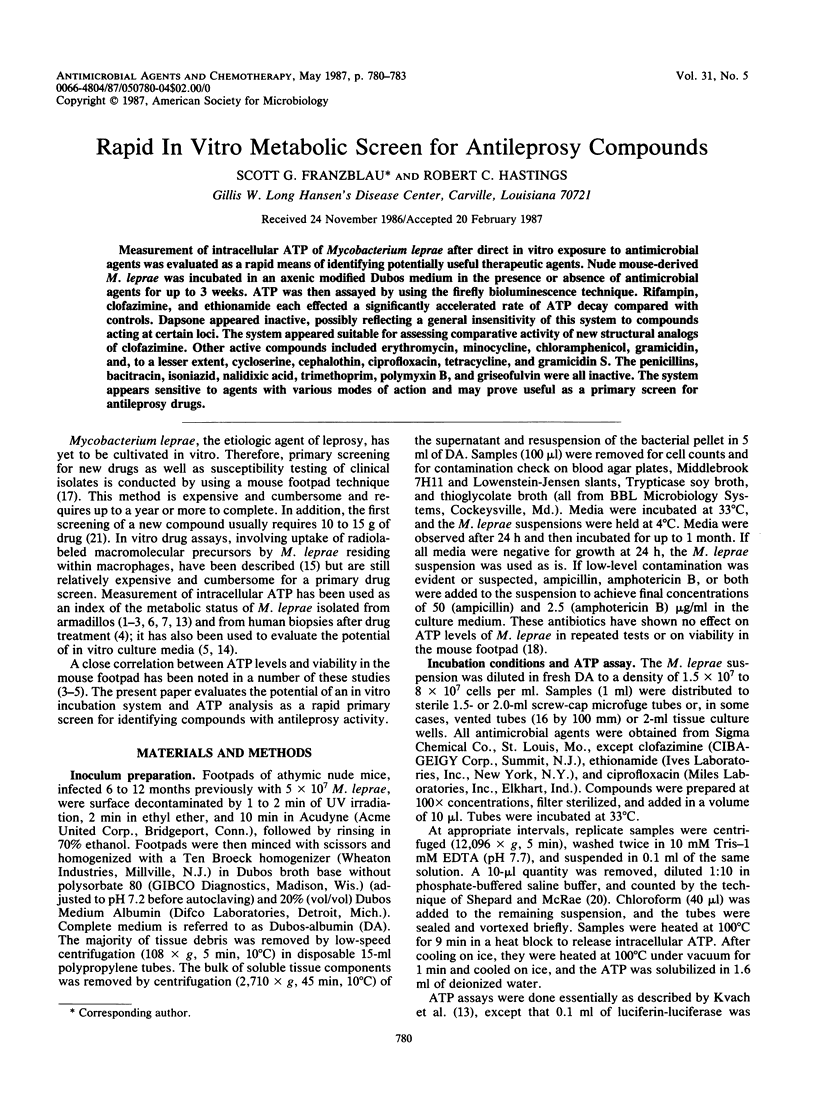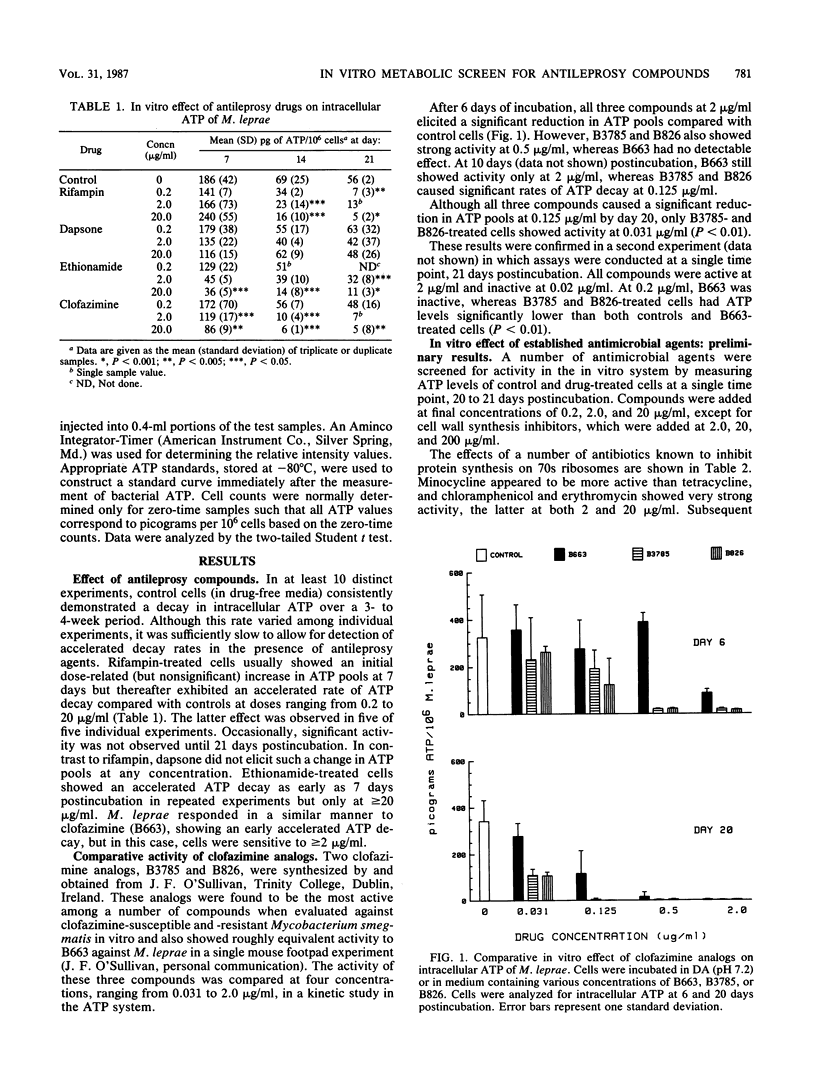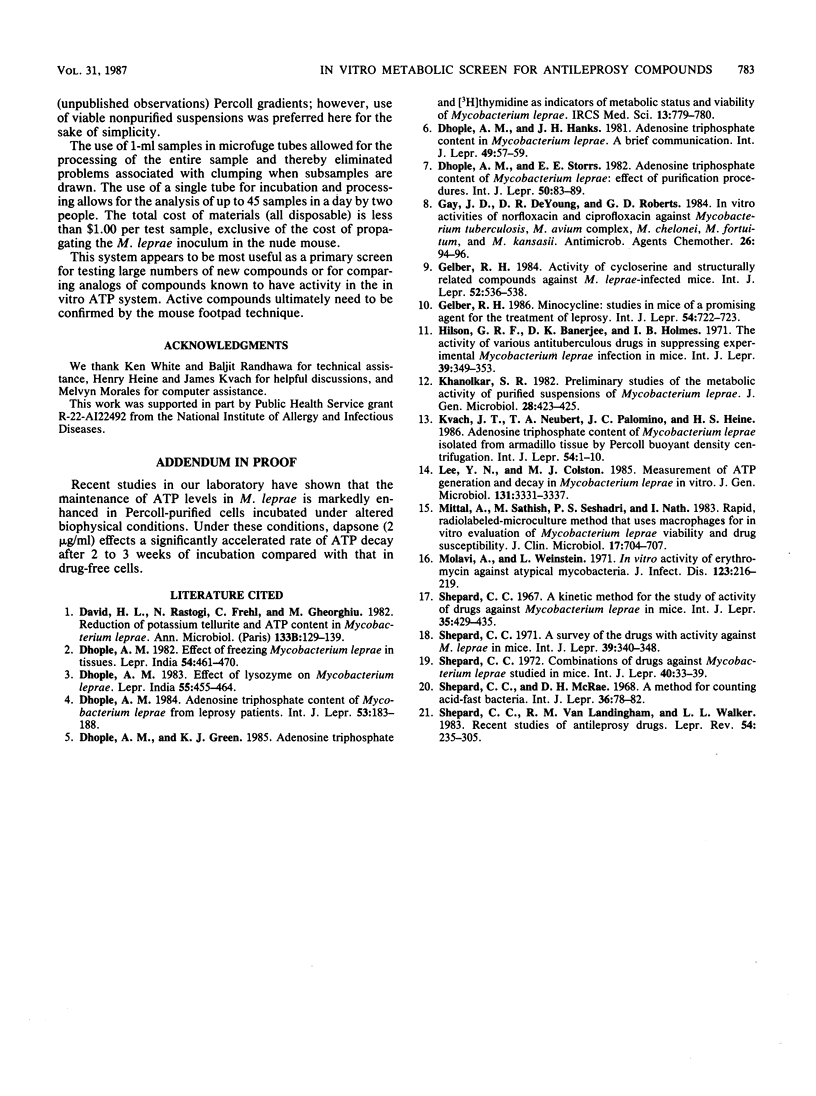Abstract
Measurement of intracellular ATP of Mycobacterium leprae after direct in vitro exposure to antimicrobial agents was evaluated as a rapid means of identifying potentially useful therapeutic agents. Nude mouse-derived M. leprae was incubated in an axenic modified Dubos medium in the presence or absence of antimicrobial agents for up to 3 weeks. ATP was then assayed by using the firefly bioluminescence technique. Rifampin, clofazimine, and ethionamide each effected a significantly accelerated rate of ATP decay compared with controls. Dapsone appeared inactive, possibly reflecting a general insensitivity of this system to compounds acting at certain loci. The system appeared suitable for assessing comparative activity of new structural analogs of clofazimine. Other active compounds included erythromycin, minocycline, chloramphenicol, gramicidin, and, to a lesser extent, cycloserine, cephalothin, ciprofloxacin, tetracycline, and gramicidin S. The penicillins, bacitracin, isoniazid, nalidixic acid, trimethoprim, polymyxin B, and griseofulvin were all inactive. The system appears sensitive to agents with various modes of action and may prove useful as a primary screen for antileprosy drugs.
Full text
PDF



Selected References
These references are in PubMed. This may not be the complete list of references from this article.
- David H. L., Rastogi N., Frehel C., Gheorghiu M. Reduction of potassium tellurite and ATP content in Mycobacterium leprae. Ann Microbiol (Paris) 1982 Jul-Aug;133(1):129–139. [PubMed] [Google Scholar]
- Dhople A. M. Adenosine triphosphate content of Mycobacterium leprae from leprosy patients. Int J Lepr Other Mycobact Dis. 1984 Jun;52(2):183–188. [PubMed] [Google Scholar]
- Dhople A. M. Effect of freezing Mycobacterium leprae in tissues. Lepr India. 1982 Jul;54(3):461–470. [PubMed] [Google Scholar]
- Dhople A. M. Effect of lysozyme on Mycobacterium leprae. Lepr India. 1983 Jul;55(3):455–464. [PubMed] [Google Scholar]
- Dhople A. M., Hanks J. H. Adenosine triphosphate content in Mycobacterium leprae. A brief communication. Int J Lepr Other Mycobact Dis. 1981 Mar;49(1):57–59. [PubMed] [Google Scholar]
- Dhople A. M., Storrs E. E. Adenosine triphosphate content of Mycobacterium leprae: effect of purification procedures. Int J Lepr Other Mycobact Dis. 1982 Mar;50(1):83–89. [PubMed] [Google Scholar]
- Gay J. D., DeYoung D. R., Roberts G. D. In vitro activities of norfloxacin and ciprofloxacin against Mycobacterium tuberculosis, M. avium complex, M. chelonei, M. fortuitum, and M. kansasii. Antimicrob Agents Chemother. 1984 Jul;26(1):94–96. doi: 10.1128/aac.26.1.94. [DOI] [PMC free article] [PubMed] [Google Scholar]
- Gelber R. H. Activity of cycloserine and structurally related compounds against M. leprae-infected mice. Int J Lepr Other Mycobact Dis. 1984 Dec;52(4):536–538. [PubMed] [Google Scholar]
- Hilson G. R., Banerjee D. K., Holmes I. B. The activity of various antituberculous drugs in suppressing experimental Mycobacterium leprae infection in mice. Int J Lepr Other Mycobact Dis. 1971 Apr-Jun;39(2):349–353. [PubMed] [Google Scholar]
- Khanolkar S. R. Preliminary studies of the metabolic activity of purified suspensions of Mycobacterium leprae. J Gen Microbiol. 1982 Feb;128(2):423–425. doi: 10.1099/00221287-128-2-423. [DOI] [PubMed] [Google Scholar]
- Kvach J. T., Neubert T. A., Palomino J. C., Heine H. S. Adenosine triphosphate content of Mycobacterium leprae isolated from armadillo tissue by Percoll buoyant density centrifugation. Int J Lepr Other Mycobact Dis. 1986 Mar;54(1):1–10. [PubMed] [Google Scholar]
- Lee Y. N., Colston M. J. Measurement of ATP generation and decay in Mycobacterium leprae in vitro. J Gen Microbiol. 1985 Dec;131(12):3331–3337. doi: 10.1099/00221287-131-12-3331. [DOI] [PubMed] [Google Scholar]
- Mittal A., Sathish M., Seshadri P. S., Nath I. Rapid, radiolabeled-microculture method that uses macrophages for in vitro evaluation of Mycobacterium leprae viability and drug susceptibility. J Clin Microbiol. 1983 Apr;17(4):704–707. doi: 10.1128/jcm.17.4.704-707.1983. [DOI] [PMC free article] [PubMed] [Google Scholar]
- Molavi A., Weinstein L. In-vitro activity of erythromycin against atypical mycobacteria. J Infect Dis. 1971 Feb;123(2):216–219. doi: 10.1093/infdis/123.2.216. [DOI] [PubMed] [Google Scholar]
- Shepard C. C. A survey of the drugs with activity against M. leprae in mice. Int J Lepr Other Mycobact Dis. 1971 Apr-Jun;39(2):340–348. [PubMed] [Google Scholar]
- Shepard C. C. Combinations of drugs against Mycobacterium leprae studied in mice. Int J Lepr Other Mycobact Dis. 1972 Jan-Mar;40(1):33–39. [PubMed] [Google Scholar]
- Shepard C. C., McRae D. H. A method for counting acid-fast bacteria. Int J Lepr Other Mycobact Dis. 1968 Jan-Mar;36(1):78–82. [PubMed] [Google Scholar]


